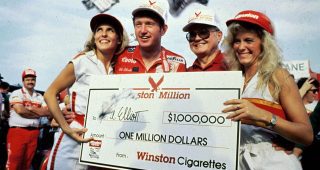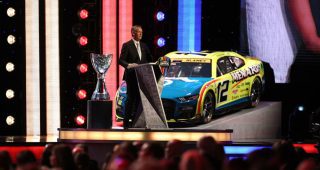Throughout the 2024 NASCAR season, Ken Martin, director of historical content for the sanctioning body, will offer his suggestions on which historical races fans should watch from the NASCAR Classics library in preparation for each race weekend.
Martin has worked exclusively for NASCAR since 2008 but has been involved with the sport since 1982, overseeing various projects. He has worked in the broadcast booth for hundreds of races, assisting the broadcast team with different tasks. This includes calculating the “points as they run” for the historic 1992 finale, the Hooters 500 at Atlanta Motor Speedway.
The following suggestions are Ken‘s picks to watch before this Sunday‘s Cook Out Southern 500 at Darlington Raceway.
Olivia, North Carolina‘s Herb Thomas captured the NASCAR Cup Series by storm upon the creation of the series.
Thomas made his debut in 1949, finishing 29th in the first race in series history. He went on to race three more times that season before expanding his schedule in 1950. That season saw Thomas make 13 starts and capture the first victory of his career, which came at Martinsville Speedway in October.
The next four seasons saw Thomas hoist the series championship two times, while also finishing second in points the other two seasons. He won 39 races over the stretch while leading over 6,000 laps.
He entered the 1955 season as the only two-time champion, but his 40 career victories were five more than the second and third-place drivers, Lee Petty and Tim Flock, had combined.
Most of Thomas‘ victories came behind the wheel of the Fabulous Hudson Hornet, the famed No. 92 Hudson. Thomas also had victories in a Plymouth and an Oldsmobile.
Change came to Thomas in 1955 as his time driving a Hudson slowly went away. Thomas was behind the wheel of not only a Hudson but a Packard, Buick and a Chevrolet.
His victory at Raleigh Speedway in August 1955, while driving a Buick, marked his first win in a different make since 1951.
Thomas arrived at Darlington the following week for the Southern 500 in a Chevrolet, qualifying eighth in the 69-car field.
Thomas bided his time as the laps during the marathon event slowly passed by. He took the lead for the first time on the 279th lap and went on to lead 76 of the final 88 laps en route to Victory Lane.
It was just the second-ever victory for Chevrolet in the Cup Series as Fonty Flock took his No. 14 Chevrolet to Victory Lane at Columbia Speedway in March 1955.
The race took nearly 5 ½ hours to complete.
The sixth annual Southern 500 at Darlington Raceway continued the trend of racing on Labor Day, which always fell on a Monday.
Three of those victories went to Herb Thomas, who entered the race in 1956 as the defending champion of the event. Johnny Mantz (who won the inaugural event in 1950), Fonty Flock and Buck Baker were the other three drivers who were crowned Southern 500 champions through the first six events.
The 70-car race was full of names that were or became recognizable to race fans over the years.
The usual suspects like Lee Petty, Tim Flock, Rex White, Buck Baker and Thomas were in the field. As were other drivers such as Rex White, Joe Weatherly, Parnelli Jones, Ralph Moody and Curtis Turner.
Turner, of Roanoke, Virginia, was a 32-year-old driver who had driven mostly part-time since the series‘ inception in 1949. He made 16 of the 19 starts in 1950, winning four times and finishing fifth in points. Beyond that, he barely raced over 50% of any of the season schedules, including the 1956 season.
He qualified his No. 99 Ford in 11th for the Southern 500 at Darlington in 1956, as Speedy Thompson put his No. 57 Chrysler on the pole.
Thompson was in the midst of a breakout season, one where the 30-year-old North Carolina native had already captured seven checkered flags.
The 500-mile event saw Thompson lead 15 laps early but never reclaim the lead, despite being fast enough to come home with a second-place finish.
Turner dominated the race, leading four times for 224 laps, on his way to his 11th career Cup Series victory.
Marvin Panch, Jim Reed and Paul Goldsmith rounded out the remainder of the top five.
Tim Flock, who eventually captured the 1956 championship, led 19 laps and finished 12th.
Something clicked for Bill Elliott and his No. 9 Melling Racing Ford at the end of the 1984 season, and the rest of the Cup Series was put on notice because of it.
Elliott ended the season with a third-place finish at Martinsville, a win at Charlotte Motor Speedway, an eighth at North Wilkesboro Speedway, another win at Rockingham Speedway, a runner-up at Atlanta Motor Speedway and a fourth-place result in the finale at Riverside International Raceway.
It was more signs of a breakout for Elliott, who now had finished third in points for two consecutive seasons. Little did anybody know the domination that Elliott and team would bring in 1985.
A dominating victory from the pole position in the season-opening Daytona 500 showed that Elliott might be the driver to beat for the championship.
He won again a few weeks later at Atlanta and then again two weeks later at Darlington from the pole again.
A few weeks later his victory at Talladega Superspeedway not only gave him his fourth win over the first nine races of the season but put him as a real contender for a new program rolled out to NASCAR drivers in 1985.
R.J. Reynolds company, which sponsored the NASCAR Cup Series at the time, announced a new program for the 1985 season called the “Winston Million.”
The program gave drivers a chance at an incredible $1,000,000 bonus check if they captured victories in three of the season‘s four biggest races.
It was only May and Elliott had won the Daytona 500, as well as the race at Talladega. This gave him two victories toward the potential bonus money. He now needed to win either the Coca-Cola World 600 at Charlotte in May or the Southern 500 at Darlington in September to capture the prize.
Elliott looked poised to go three-for-three as he sat on the pole at Charlotte. He led 81 laps before mechanical issues relegated him to a disappointing 18th-place finish.
This left Elliott with one opportunity to chase the million-dollar prize, the Southern 500 at Darlington.
With a few months left to prepare for the race at Darlington, all while chasing his first championship, Elliott somehow was hotter than ever.
He managed to arrive at Darlington in September on a torrid stretch, with victories in four of the previous seven races. Dating back further, he had won six of eleven and eleven of 24.
Elliott also was carrying the series points lead, with a 138-point advantage over Darrell Waltrip in the standings.
It was absolutely no surprise that Elliott put his No. 9 Ford on the pole yet again, this being his 10th of the season and his seventh over the previous 10 races.
Elliott, who won at Darlington in the spring, had to battle strong runs from Dale Earnhardt and Cale Yarborough if he wanted to capture the bonus money. Earnhardt led 147 laps and Yarborough 25 before both had issues that allowed Elliott to claim the top spot.
Elliott went on to lead the final 44 laps, capturing the checkered flag, the new $1,000,000 bonus and the nickname “Million Dollar Bill” along the way.
Money poured onto Elliott and his team in Victory Lane, after their total payday of $1,053,725. For perspective, he earned $185,500 for capturing the season-opening Daytona 500 in February.
The program was a huge success for the R.J. Reynolds team and NASCAR as a whole as Elliott‘s chase of the prize and following success landed him in the national media. This included Elliott gracing the cover of Sports Illustrated.
Read the full article here
























